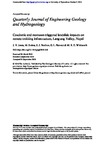Coseismic and monsoon-triggered landslide impacts on remote trekking infrastructure, Langtang Valley, Nepal
| dc.contributor.author | Jones, JN | |
| dc.contributor.author | Stokes, M | |
| dc.contributor.author | Boulton, Sarah | |
| dc.contributor.author | Bennett, GL | |
| dc.contributor.author | Whitworth, MRZ | |
| dc.date.accessioned | 2019-10-02T07:36:53Z | |
| dc.date.available | 2019-10-02T07:36:53Z | |
| dc.date.issued | 2020-05 | |
| dc.identifier.issn | 1470-9236 | |
| dc.identifier.issn | 2041-4803 | |
| dc.identifier.uri | http://hdl.handle.net/10026.1/14953 | |
| dc.description.abstract |
In 2015, the Mw 7.8 Gorkha earthquake struck Nepal, triggering thousands of landslides across the central and eastern Himalayas. These landslides had many adverse effects, including causing widespread damage to low-grade transport routes (e.g. tracks, footpaths) in rural regions that depend on tourism for survival. Langtang Valley is a glacial–periglacial landscape located 60 km north of Kathmandu. It is one of the most popular trekking regions in Nepal and has been severely affected by Gorkha earthquake-triggered and monsoon-triggered landsliding. Here, qualitative and quantitative observations from fieldwork and remote sensing are used to describe the materials and geomorphology of the landslides across Langtang Valley, and to quantify the extent to which coseismic and monsoon-triggered landslides have affected Langtang’s trekking infrastructure. The dominant bedrock materials involved within Langtang landslides are found to be a range of gneisses and intruded leucogranites. In total, 64 landslides are found to have intersected trekking paths across Langtang, with coseismic and monsoon-triggered landslides having an impact on c. 3 km and 0.8 km of path respectively. It is observed that the practice of reconstructing paths through unstable landslide deposits is leaving the trekking infrastructure across Langtang increasingly vulnerable to future failure. | |
| dc.format.extent | 159-166 | |
| dc.language | en | |
| dc.language.iso | en | |
| dc.publisher | Geological Society of London | |
| dc.title | Coseismic and monsoon-triggered landslide impacts on remote trekking infrastructure, Langtang Valley, Nepal | |
| dc.type | journal-article | |
| dc.type | Journal Article | |
| plymouth.author-url | https://www.webofscience.com/api/gateway?GWVersion=2&SrcApp=PARTNER_APP&SrcAuth=LinksAMR&KeyUT=WOS:000530644200001&DestLinkType=FullRecord&DestApp=ALL_WOS&UsrCustomerID=11bb513d99f797142bcfeffcc58ea008 | |
| plymouth.issue | 2 | |
| plymouth.volume | 53 | |
| plymouth.publication-status | Published | |
| plymouth.journal | Quarterly Journal of Engineering Geology and Hydrogeology | |
| dc.identifier.doi | 10.1144/qjegh2019-048 | |
| plymouth.organisational-group | /Plymouth | |
| plymouth.organisational-group | /Plymouth/Faculty of Science and Engineering | |
| plymouth.organisational-group | /Plymouth/Faculty of Science and Engineering/School of Geography, Earth and Environmental Sciences | |
| plymouth.organisational-group | /Plymouth/REF 2021 Researchers by UoA | |
| plymouth.organisational-group | /Plymouth/REF 2021 Researchers by UoA/UoA07 Earth Systems and Environmental Sciences | |
| plymouth.organisational-group | /Plymouth/Research Groups | |
| plymouth.organisational-group | /Plymouth/Research Groups/Marine Institute | |
| plymouth.organisational-group | /Plymouth/Users by role | |
| plymouth.organisational-group | /Plymouth/Users by role/Academics | |
| dcterms.dateAccepted | 2019-09-24 | |
| dc.rights.embargodate | 2020-10-3 | |
| dc.identifier.eissn | 2041-4803 | |
| dc.rights.embargoperiod | Not known | |
| rioxxterms.versionofrecord | 10.1144/qjegh2019-048 | |
| rioxxterms.licenseref.uri | http://www.rioxx.net/licenses/all-rights-reserved | |
| rioxxterms.licenseref.startdate | 2020-05 | |
| rioxxterms.type | Journal Article/Review |


